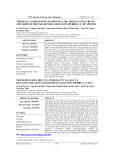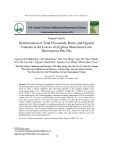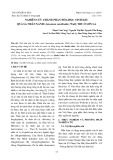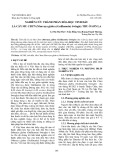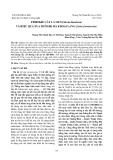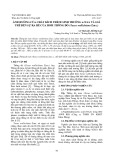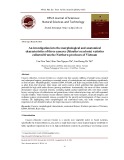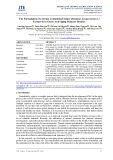
CAN THO JOURNAL OF SCIENCE AND TECHNOLOGY - No.05 February, 2025
68
EXTRACTION AND INVESTIGATION OF THE CHEMICAL
COMPOSITION OF ESSENTIAL OIL FROM Ocimum africanum L.
Nguyen Van Kiet
1
, Hoang Thi Phuong Thao
1
, Thai Van Phat
2
,
Luu Thien Phat
2
, Le Thi Anh Nhu
2
, and Luu Nhut Nam
2
1Can Tho University of Technology
2Student of the Faculty of Biological, Chemical, and Food Technology
Email: nvkiet@ctuet.edu.vn
ARTICLE INFO
Received: 07/01/2025
Revised: 14/02/2025
Accepted: 17/02/2025
Keywords: Citral, essential oil, GC-
MS, Ocimum africanum, the steam
distillation method.
A
BSTRACT
Ocimum africanum L. is a distinctive Vietnamese herb,
especially common in Tuy Hoa, Phú Yen. This study focuses on
extracting and analyzing the chemical composition of the
essential oil derived from the leaves of Ocimum africanum. The
essential oil was extracted using the steam distillation method
and its chemical composition was analyzed using gas
chromatography-mass spectrometry (GC-MS). The research
results indicate that the main component in Ocimum africanum
essential oil is citral, a compound with a characteristic aroma
that exhibits insect-repellent properties and has antimicrobial
activity, particularly against pathogenic bacteria.
1. INTRODUCTION
Ocimum africanum L. belonging to the
family of Lamiaceae, is a familiar herb to
many Vietnamese people. With its distinctive
aroma and ability to thrive in various climates,
Ocimum africanum has been used in cuisine
as a spice and for treating common ailments
such as colds, coughs, sore throats, and poor
digestion (Do, 2020). Chloroform and
methanol extracts, along with white Ocimum
africanum's essential oil, have shown
inhibitory effects on the growth of
Streptococcus pyogenes and Escherichia coli
(Manjula-Bomma et al., 2018). Additionally,
the methanol extract of white Ocimum
africanum leaves demonstrates strong
antioxidant activity (IC50 = 174.04 µg/mL)
(Timotius et al., 2021).
In Vietnam, research on Ocimum
africanum remains limited. Nguyen et al.
(2021) indicated that Ocimum africanum's
essential oil exhibits the strongest effect
against gram-positive methicillin-sensitive
Staphylococcus aureus and also demonstrates
inhibitory effects on gram-negative bacteria
such as E. coli and P. aeruginosa. Phan et al.
(2023) conducted a research to evaluate the
antibacterial and antioxidant activities of
fractionated extracts (ethanol, hexane, and
ethyl acetate) from Ocimum africanum. The
results revealed that white basil has potential
applications in human disease prevention and
treatment
Around the world, several studies have
been conducted on essential oil extracted from
the Ocimum africanum leaves. The chemical
composition of Ocimum africanum essential
oil depends on the harvest time, climate, and
extraction method. The two main compounds
were founded in Ocimum africanum essential
oil are geraniol and citral (Padalia et al., 2018;
Timotius et al., 2021).
Overall, research on the extraction and
chemical composition analysis of Ocimum
africanum essential oil remains highly
limited. In this study, we investigated several

CAN THO JOURNAL OF SCIENCE AND TECHNOLOGY - No.05 - February, 2025
69
conditions for extracting Ocimum africanum
essential oil using the steam distillation
method. Additionally, the chemical
composition of the essential oil was
determined using gas chromatography-mass
spectrometry (GC-MS).
2. MATERIALS AND METHODS
2.1. Materials and measurements
2.1.1. Materials: Ocimum africanum
leaves were collected in Ninh Thuan province,
Vietnam, in August 2024. Mature, pest-free
leaves were selected, washed, removed
impurities and stored at 4-8
o
C to use
throughout the experiment.
2.1.2. Measurements: Essential oil
distillation kit using steam distillation method;
gas chromatography-mass spectrometry (GC-
MS) machine: Quadrupole 7890A Agilent
Technologies; moisture balance HX204.
2.2. Methods
2.2.1. Essential oil extraction method
Ocimum africanum leaves were pre-
processed, weighed, and chopped into small
pieces before being placed into a 2 L round-
bottom flask. The essential oil was extracted
using an essential oil distillation kit through the
steam distillation method (Le, 2008). The
mixture consists of essential oil and steam,
after passing through the condensation system,
were collected at the upper layer in the oil
collection apparatus. The content of essential
oil was calculated using formula (1). The
collected essential oil was dehydrated using
sodium sulfate and stored in a brown glass jar
at a temperature of 3-5°C.
The content of essential oil (mL/100 g)
.100
(1 )
V
m a
(1)
(V (mL): volume of essential oil; m (g):
the mass of the material; a: the humidity of
the material)
2.2.2. Identify the sensory evaluation and
density of essential oil
Identify the clarity and color of essential
oil: Prepare a dry, clean, and transparent test
tube. Pour 10 mL of essential oil into the test
tube. Observe the clarity and color of the
essential oil. If the essential oil appears cloudy
or not transparent, it indicates the presence of
impurities and water.
Identify the scent of essential oil: Place a
few drops of essential oil onto filter paper.
Identify the scent of the essential oil and
assess it every 15 minutes. Repeat the process
five times. Record observations on the
intensity of the scent after each assessment.
Identify the taste of essential oil: Prepare a
clean, dry glass dish. Add 1.0 gram of
granulated sugar. Drop a few drops of
essential oil into the dish, mix well, and then
use your tongue to identify the taste of the
mixture. Record observations on the nature
(sweetness and bitterness) and the intensity of
the taste after each trial.
Identify the density of essential oil: The
density of essential oil was identified by using
a hydrometer. The density of essential oil was
calculated using formula (2).
The density of essential oil d
1
2
P P
P P
(2)
(P, P1, and P2 (g) represent the masses of
the hydrometer, the hydrometer filled with
essential oil, and the hydrometer filled with
water, respectively).
2.2.3. Identify the chemicals of essential oil
The chemical composition of the essential
oil extracted from Ocimum africanum leaves
was analyzed using the gas chromatography-
mass spectrometry (GC-MS) method at the
Can Tho Center for Standards, Metrology, and
Quality Engineering. The GC-MS system
used was Thermo Trace GC Ultra - ITQ900.

CAN THO JOURNAL OF SCIENCE AND TECHNOLOGY - No.05 February, 2025
70
The TG-SQC column was 30 min length, with
an internal diameter of 0.25 mm, and a film
thickness of 0.25 μm. Helium was used as the
carrier gas. The injector temperature was set
at 230°C, and the detector temperature was
maintained at 260°C. The oven temperature
program started at 60°C (held for 2 minutes),
increased at 4°C/min to 200°C (held for 5
minutes), and then increased at 10°C/min to
260°C (held for 10 minutes). To prevent
overloading the chromatography column and
MS detector, the essential oil was diluted at a
50:1 ratio in hexane, with a split 20:1 ratio in
the injector.
2.2.4. Experimental Arrangement Method
Figure 1. Experimental setup diagram
The experiment was designed based on a
single-variable model. The factors
investigated include the solvent-to-material
ratio (mL/g) and distillation time (minutes).
The experimental steps were arranged as
shown in Figure 1. Each experiment was
repeated three times. The average essential oil
content among the experiments was compared
using the MiniTab 2021 statistical software
with a 95% confidence interval.
3. RESULTS AND DISCUSSION
3.1. The material’s moisture content
Moisture content is a parameter used to
determine the essential oil content. The
material's moisture content was measured
using a moisture analyzer. In this study, the
moisture content of the material was
determined to be 88.39 ± 0.21%. The
relatively high moisture content provides
favorable conditions for microbial growth,
making the material prone to spoilage.
Therefore, the material should be stored at an
appropriate temperature or dried to reduce
moisture.
3.2. Factors affecting the essential oil
extraction process
3.2.1. The solvent - material ratio
The experiment was designed based on a
single-variable model, with the extraction
time fixed at 240 minutes and the material
weight set at 400 g. The results of
investigating the effect of the solvent-to-
material ratio on essential oil content are
presented in Table 1.
Table 1. Effect of the solvent-material ratio
on essential oil content
No. The solvent-
material ratio
(mL/g)
The essential oil
content
(%)
1 1.0 0.182
e
0.011
2 1.5 0.187
d
0.015
3 2.0 0.195
c
0.009
4 2.5 0.210
b
0.012
5 3.0 0.274
a
0.018
6 3.5 0.275
a
0.014
7 4.0 0.279
a
0.008
According to these results, as the solvent-
to-material ratio increased from 1.0 to 3.0
(mL/g), the essential oil content gradually
rose from 0.182 to 0.274 mL/100 g. The
solvent impacts the cell membrane, breaking
it down and facilitating the release of
essential oil. Therefore, an increase in the
amount of solvent corresponds to an increase
in essential oil content (Le et al., 2023).

CAN THO JOURNAL OF SCIENCE AND TECHNOLOGY - No.05 - February, 2025
71
However, when the solvent-to-material
ratio was further increased from 3.0 to 4.0
mL/g, the essential oil content exhibited no
statistically significant difference at the 5%
significance level. This indicates that a
solvent-to-material ratio of 3.0 mL/g is the
most suitable for extracting essential oil from
the material. An extraction ratio 3.0 mL/g was
selected to optimize solvent usage and
minimize costs. These findings align with the
research of Le et al. (2023), which also
examined the effect of solvent-to-material
ratio on the essential oil content of Ocimum
basilicum var leaves.
3.2.2. Extraction time
The experiment was designed using a
single-variable model, with fixed variables
including a material weight of 400 g and a
solvent volume of 1200 mL. The results of the
investigation into the effect of extraction time
on essential oil content are presented in Table 2.
Table 2. Effect of Extraction Time on
essential oil content
No. The extraction
Time
(minutes)
The essential oil
content
(%)
1 60 0.102
d
0.008
2 90 0.124
c
0.011
3 120 0.176
b
0.014
4 150 0.250
a
0.009
5 180 0.254
a
0.012
6 210 0.256
a
0.016
7 240 0.259
a
0.007
According to these results, increasing the
extraction time from 60 to 150 minutes led to
a gradual rise in essential oil content from
0.102 to 0.250 mL/100 g. However, further
increasing the extraction time from 150 to 240
minutes did not result in statistically
significant differences in the obtained
essential oil content.
Short extraction times (less than 150
minutes) are insufficient to extract all the
essential oil from the material. An extraction
time of 150 minutes is optimal for essential
oil extraction. Longer extraction times
(greater than 150 minutes) may lead to energy
wastage and potentially impact the quality of
the essential oil (Le et al., 2023).
3.3. The quality of essential oil
3.3.1. The sensory evaluation score and
density of essential oil
The essential oil extracted from Ocimum
africanum leaves using the steam distillation
method is in a liquid, transparent state, with
an orange-yellow color, a characteristic aroma
(similar to the fragrance of Cymbopogon
citratus essential oil) and a slightly sour taste
(Figure 2). The density of Ocimum africanum
essential oil is 0.903 ± 0.001.
Figure 2. The essential oil of Ocimum
africanum leaves
3.3.2. The chemical composition of the
essential oil
The chemical composition analysis (Table
3) showed that the main components in the
essential oil of Ocimum africanum include
citral, geraniol,
-linalool, 6-methyl-5-
heptene-2-one, -caryophyllene and -
bisabolene (Figure 3).

CAN THO JOURNAL OF SCIENCE AND TECHNOLOGY - No.05 February, 2025
72
Table 3. The chemical composition of the of
Ocimum africanum’s essential oil
No. The chemical compositions Content
(%)
1
-Citral 31.03
2
-Citral 23.88
3 trans-Geraniol 5.25
4 cis-Geraniol (nerol) 5.21
5
-Linalool 4.88
6 6-Methyl-5-heptene-2-one 4.61
7
-Caryophyllene 4.47
8
-Bisabolene 4.42
9 1-Terpinen-4-ol 2.81
10 3-Hexyl hydroperoxide 1.89
11
-Cayophyllene 1.87
12 Germacrene D 1.57
13
-Bergamotene 1.35
14 2-Hexyl hydroperoxide 1.31
15 Carane. 4.5-epoxy-trans 1.30
16
-cis-Ocimene 0.93
17
-Terpineol 0.71
No. The chemical compositions Content
(%)
18 Caryophyllene oxide 0.60
19 1-Methyl-1-(2-methyl-2-
propenyl)cyclopentane 0.54
20 cis-Verbenol 0.52
21 1,1-Dimethyl-2-(2-methyl-
2-propenyl)cyclopropane 0.44
22 -Terpinene 0.41
The main components of the Ocimum
africanum’s essential oil in this study were
similar to the main components of the essential
oil of Ocimum africanum leaves (Padalia et al.,
2018; Kumar et al., 2021) and Cymbopogon
citratus essential oil (Vázquez-Briones et al.,
2015; Hanaa et al., 2019) (Table 4) but differed
in the compound content. This difference may
be due to the influence of essential oil content
in medicinal herbs on factors such as climate,
soil, and cultivation methods (Le, 2008).
Table 4. The main chemical compositions of the essential oil
The essential oil content (%)
Ocimum africanum Cymbopogon citratus
No. The chemical
compositions This study
Padalia et
al. (2018)
Kumar et
al. (2021)
Vázquez-
Briones et
al. (2015)
Hana et al.
(2012)
1 -citral (geranial) 31.03 40.4 11.04 15.97 40.72
2 -citral (neral) 23.88 33.9 10.91 19.35 34.98
3 trans-geraniol 5.25 4.9 11.30 - 0.53
4 cis-geraniol (nerol) 5.21 1.7 - - 0.17
5 linalool 4.88 3.7 9.02 0.64 1.03
6 caryophyllene 4.47 1.8 14.12 0.28
7 6-Methyl-5-
heptene-2-one 4.61 1.6 - - -
Citral imparts a characteristic lemon like
aroma to the essential oils of lemongrass. Citral
possesses many significant bioactivities such as
antimicrobial, anti-inflammatory, antiparasitic,
allelopathic and mosquito repellent. Citral is the
most valuable monoterpene in flavors,
fragrances, cosmetics, perfumery and
pharmaceuticals. It is used for the synthesis of
vitamin A and β-ionones and other specialty
chemicals. A growing number of reports
published on the bioactivities of citral, and
citral-rich essential oils have reflected their
rapidly increasing medicinal and
pharmacological significance (Ganjewala et al.,
2012). Geraniol is also present in relatively high
concentrations in the Ocimum africanum’s


